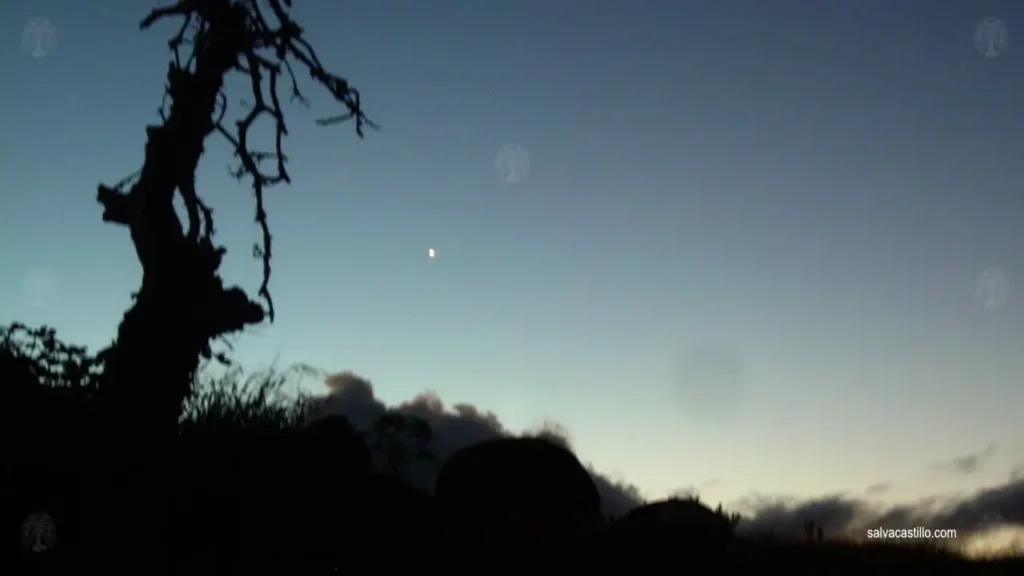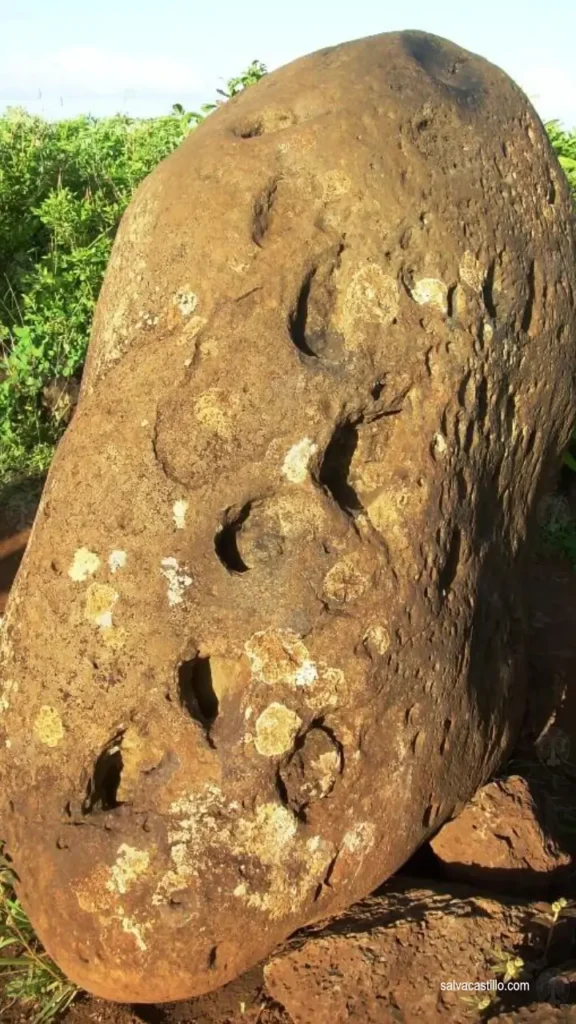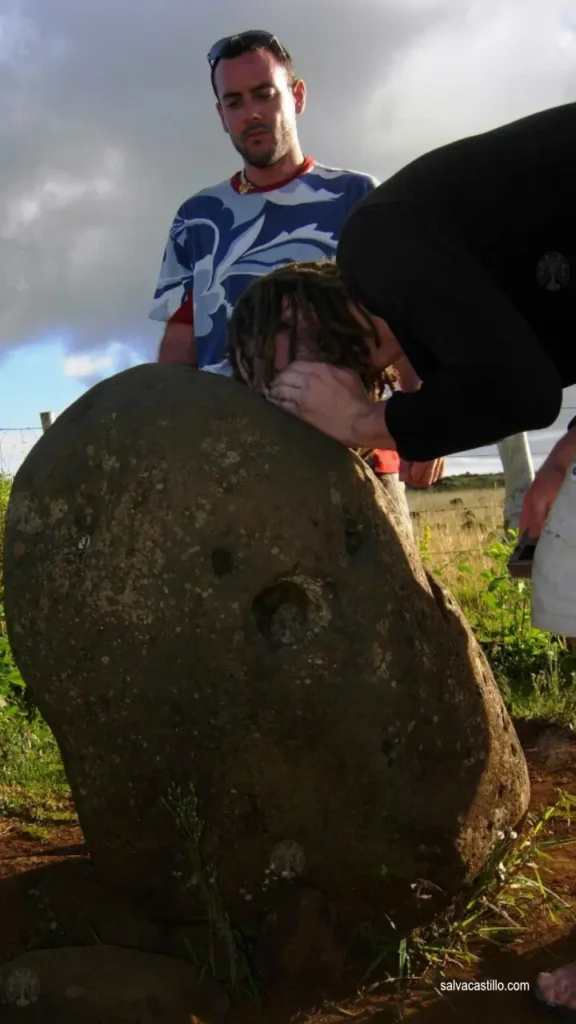The moai are anthropomorphic sculptures extracted from the slope of the Rano Raraku volcano. They weigh several tons and can rise from 2 meters high to the 11 meters that measures the largest moai ever erected, called Paro. There is another even bigger moai, of 21 meters and 270 tons, called Te Tekanga, which still rests in the place of the hillside where it began to be sculpted. There is a theory that it was abandoned before it was finished when they realized that they could not move it anywhere because of its enormous size.

The arms of the moai are sculpted resting on both sides of its belly, in a posture that in the Polynesian culture represents respect. There are some moai that are half-buried and others are completely in the air. Of those that are half-buried (especially on the slope of the Rano Raraku volcano, near the quarry), it is estimated that only a third of their total size, which corresponds to the head and part of the torso, protrudes. The trunk is buried several meters.
Of the moai that are not buried, many are found on platforms called Ahu, arranged either individually or in groups. Other moai are neither half-buried nor on a platform, so they were more unstable (or more vulnerable) and several are found throughout the island lying and broken into pieces.


A moai is “complete” when the whole has:
- The moai, main element, whose body can be carved with different ornamental motifs.
- The pukao or hat, obtained from another quarry of reddish material in the crater of another volcano called Puna Pau. This quarry was only used to obtain pukaos, which were later placed on top of the heads of some moais. In the photo below, at dusk, you can see -not without effort, sorry- three pukaos that were abandoned in the quarry.

- The eyes of the moai, made with white coral and colored material (obsidian or red rock), which represented that the moai was “alive”.
The moai were sculpted and arranged in their respective locations before the arrival of the first European explorers, probably between the 13th and 16th centuries.
Meaning of the moai
Although there is no certainty, it is commonly accepted the theory that the moai represented the ancestors of the inhabitants of the island, and could be located on platforms or Ahus near the sea, which would thus fulfill the function of altar. Their arrangement follows a general pattern:
- Moais on the slope of the Rano Raraku volcano, near the quarry: looking towards the sea.

- Moais in the Ahus: looking towards the inside of the island.
When the moais had their eyes placed on them then they represented the ancestors (Aringa ora or Living Face) observing and taking care of the inhabitants of the island (that is why they look inward from the Ahus).
On the island there were different clans competing with each other, and it is logical to think that the Ahus were associated with one clan or another. In the wars between clans, the Ahus were military targets because damaging them meant harming the ancestral lineage of the rival clan.
How the moais were transported
One of the enigmas still to be solved. As there were no hardwood trees on the island, it does not seem plausible that cranes or other complex constructive elements were built to facilitate the transfer and hoisting of these tremendous blocks of rock. Historically it was assumed that tree trunks were used along roads (roads dug in the ground) so that the moai were pushed horizontally on those trunks that served as wheels, using (or not) a sled. You may have seen in some movies boats being transported with a similar method (as in Herzog’s delightful and demented Fitzcarraldo, or in the Vikings TV series).
The owner of the lodge I slept in – yes, the breakfasts went a long way and I was one of his few guests in those days – told me, perhaps to add to the mystique, that the moai were transported by telekinesis. That these faculties have been lost in men today, but that in ancient times, there were people who had this gift of transporting objects from one place to another with the power of their mind or spirit. To my sly perplexity, he added that there is a moai located on a cliff, and that there is no other possible explanation as to how it was moved there. I never saw this moai nor have I found any reference to it, although perhaps he was referring to the submerged moai, which is just a tourist replica.
One can also consider the theory of the Ancient Astronauts, of which Erich von Däniken is a proponent, according to which the existing technology at the time was insufficient to achieve the transport of the moai, and therefore had to be external agents (extraterrestrials) who did it. I try to respect everyone, even if the theory they are proponent of does not hold the slightest amount of water. To each, its own.
My favorite theory is that the natives made the moai “to walk”. Several studies support the theory of engineer Pavel Pavel, according to which the moai were transported upright, with ropes tied around their heads, so that groups of people arranged around the statue alternately pulled and released it, causing it to pivot on its sides but at the same time moving slowly forward.
Petroglyphs
As in so many other cultures, the Rapa Nui used stone engravings to represent elements of their culture, the famous petroglyphs. The most numerous are found in the ceremonial village of Orongo, on top of the Rano Kau volcano.

In the following photo, the petroglyph seen on the edge of the rock on the upper right is the most important, as it represents the Tangata Manu or Birdman.

Pu O Hiro or the trumpet rock
Near the beach of Anakena, where the Ariki or kings resided, there is a very special rock: it is called Pu O Hiro, and it has a series of interconnected cavities.

At the top there is a hole with a very worn edge. The legend says that it was blown through this hole and the rock emitted a very characteristic sound that could be heard from a great distance. Some say that it was used to summon the different clans, although it could also have been used as a magical instrument to help fertility, or to make the fish come closer to the shore.

I went to visit with a couple of Norwegian guys I befriended in those days, and although we tried several times, the truth is that none of us produced any sounds.
